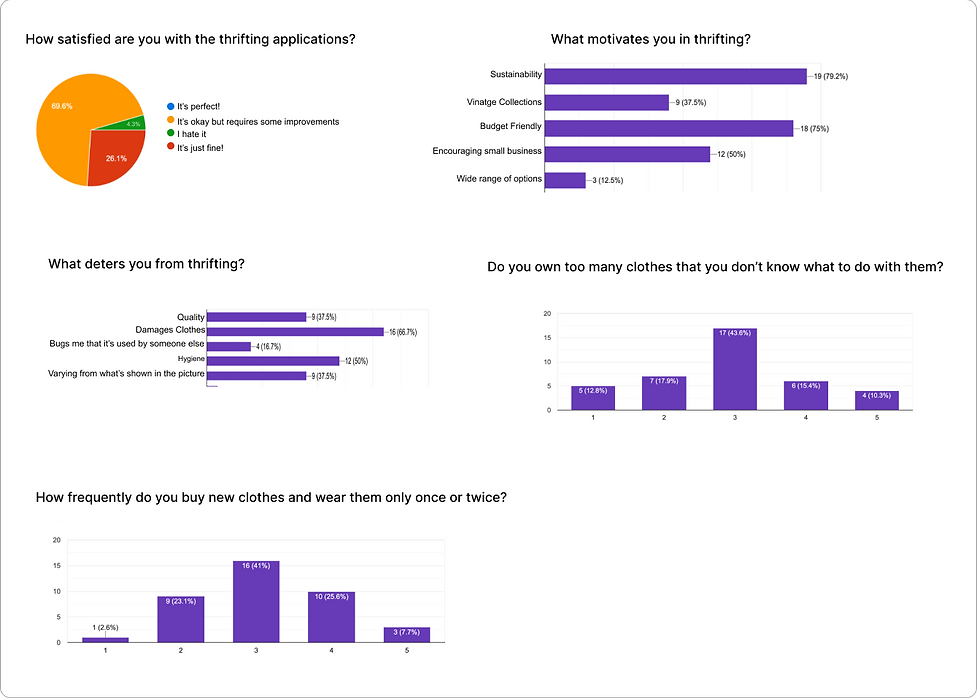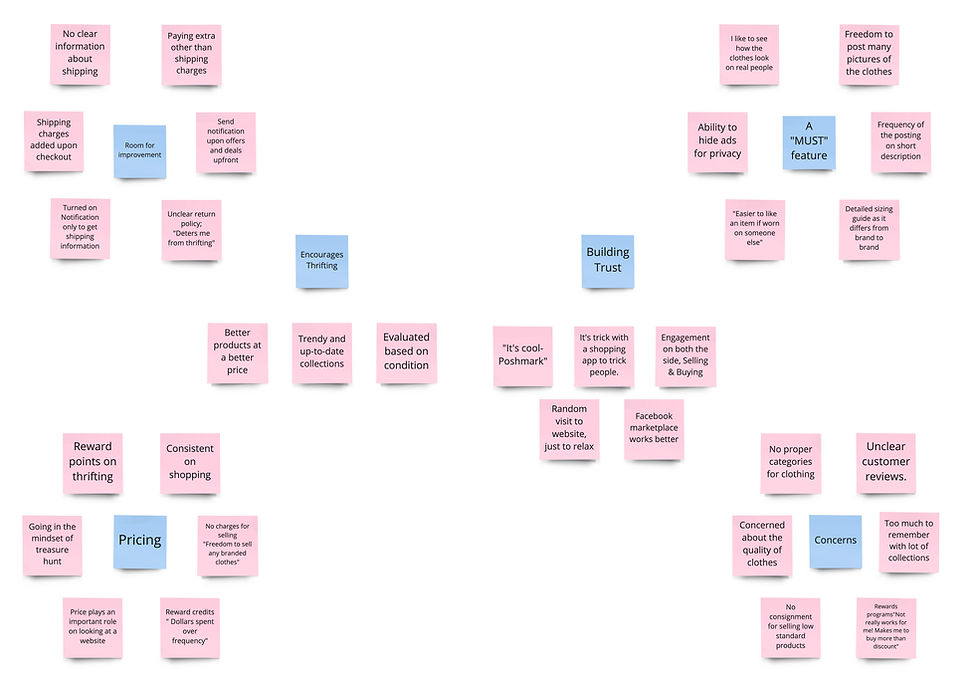
Preloved
A mobile application that makes thrifting clothes a hassle-free process
Role: UX Designer
Designed an end-to-end product, including user research, user interviews, competitive analysis, user flows, wireframing, prototyping, and usability testing.
Project Interests
My first project in the field of User Experience Design was an exciting journey of self-discovery and skill development. Through research and user interviews, I discovered my attention to detail and ability to connect with users. I also found that my passion for organization translated well to information architecture, allowing me to create easy-to-use and meaningful navigation for the application. Overall, this project allowed me to gain valuable experience and deepen my understanding of UX design.
Overview
Preloved is a thrifting application I designed through Springboard's UX Design Bootcamp. The case study elaborates on the design process of the application.
Problem
When it comes to clothing, people love to stay on top of the trend. The result is a pile of clothes that stays ignored in the closet. The amount of money wasted on clothes for every new occasion are countless.
Polluting the planet with those huge piles of ignored clothes can be warded off by reselling them; this way, we could also get premium clothes at an affordable price.
Reselling has challenges, such as trusting the clothes' quality and authenticity. People need a platform to buy and resell their preloved clothes and trust them with their products.

Design Process
I followed the user-centered design thinking process to proceed with the problem to ensure that the end users were considered with every step, starting with the research to understand the user's needs and moving through brainstorming, finding solutions, implementing, and testing them.

Empathize
The first step was empathizing with the users to understand the problem space better. Then, I conducted primary and secondary research to understand the users better.
Secondary Research
Conducting the secondary research helped me look at the problem's overview. Then, I used the existing online resources to perform the research.
The resources I used curated a researcher's visit to a local thrift store to conduct a contextual inquiry, deploy a short survey online, and conduct more detailed user interviews to get the user's needs and pain points when using a thrifting application.
Some of the insights from the secondary research were:
-
Price, variety, and sustainability are the factors that motivate people; cleanliness and quality are the factors that deter them from thrifting.
-
The user's physical shopping experience is depicted as a behavior of going to the desired section and browsing from one end to another.
-
From the article's demographic-focused questions, I learned that no single gender, employment status, or age group was more likely to shop at thrift stores than another.
-
Online shopping and delivery would increase convenience for most users.
Primary Research
I started with an online survey followed by user interviews to get quantitative and qualitative data. Then, I conducted an online screener survey to get the quantitative data to know who my focus would be and to recruit potential participants for the user interview.
As a result, I got responses from 24 users, from which six potential participants were selected for the user interview.
The insights from the survey below provided data that people aren't satisfied with the existing application, and there were quality concerns that make people hesitant to buy preloved products; some users wanted to encourage sustainability, and small business owners, this helped me to move forward with the problem.
These are key questions that helped me recruit participants for the user interview.

Survey results from primary research
User Interviews
With the quantitative data lined up, I started to conduct the user interview to understand their needs, pain points, and behaviors to help them with a better product.
The insights from the user interviews are as follows:
-
The users are concerned about the quality and damage that the pictures can't observe.
-
They feel that the consignment part is tricky, and instead, it should be clear, concise, and written in the user's language.
-
Some websites don't allow users to sell clothes that aren't branded and don't list on their website.
Define
Understanding and defining the problem is the next step after the research. Learning the user's pain points and actions is important, and I learned it by synthesizing the research.
Affinity Mapping
The first synthesis method I used was affinity mapping. I used the data collected from the user interviews to restructure them into meaningful insights. I grouped them into categories that would encourage and deter thrifting, the areas of improvement, and features that will keep the users more engaged.

Empathy Mapping
Then, I used an empathy map to organize the insights, observations, and quotes collected from the user interviews to understand better the user's pain points, goals, feelings, thoughts, and behaviors.
I curated the data collected into three empathy maps to better empathize from the user's perspective.
.png)

User Personas
The final step I used in synthesizing my research was creating user personas. I used this model to gain a deeper understanding of the user base that would potentially be using this product. From my research, I found two potential user bases using my application.


Ideate
After my research and synthesis, I moved on to the ideation phase to find a solution that would help resolve the problem.
From the research insights, I listed a few key functions that would need more attention are:
-
Educating the users about the consignment in a language the users can understand.
-
Allowing the users to sell all brand clothes and pay them accordingly.
-
Making the reselling process easy by selling the items on behalf of the user and making it a hassle-free process.
-
Paying the users within 2-3 days since their clothes are received.
-
Providing the timeline of the clothes and letting the users know about the quality check in the process.
I also believe promoting sustainability among the users would encourage them to buy and sell their preloved items. As a solution, I added the group chats feature where the users can join one of the groups and bring their contribution toward sustainability and gain knowledge about it.
User Stories
In the next step forward, I used the user story map to determine a minimum viable product with only the essential features an early user would need to complete the critical tasks.

Information Architecture
Interaction should be made easier for the users to navigate through the application, and information architecture comes into play. Information architecture (aka blueprint of the application) is used to organize and structure the information to help the users complete a task in the application.
Sitemap
I started by creating a site map for the application, which included various screens and their hierarchy with the product.

User Flows
I depicted four user flows that would entail the red routes the user would need to take to perform the tasks within the application.

Card Sorting
The final step in the ideation phase is to understand and discover how the users categorize information; I used the card sorting technique, which helped me organize the application so that each user could navigate and understand their way in the app.
Prototype
After the ideation, I started to plan the design of the application to help me visualize how the product will look like and to eliminate the design problems in the future.
Sketch
Starting to sketch the red routes of my application, I was getting numerous design ideas, and so to choose the best solutions among those ideas, I used a crazy 8 sketch method to visualize the best outcome.

Low-Fidelity Wireframes
I started to digitize the paper prototype to visually represent the user interface which helped me to determine the layout of my application and how I would place the elements on all the pages without getting distracted by the color, typography, and iconography.

Visual Design
After designing the application's layout, I started to visualize the product. Then, I created a mood board that would match my idea's theme and made a unified design decision with color and typography.

High-Fidelity Prototype
Incorporating the UI elements into the low-fidelity wireframes, I started designing the high-fidelity prototype of the product. Using Figma, I created a visually engaging clickable prototype of the red routes I defined in the ideating phase.
Test
After creating the high-fidelity mockups, the final [hase in the design process is to test the application and get usability feedback from users.
Usability Testing
I conducted moderated usability testing with 4 users. The test aimed to identify the usability or navigational issues that users might encounter while interacting with the product.

Conclusion
As interesting as it was working on this problem, I got to learn how the user experience will influence an application. I was fascinated by how empathizing with users and walking in their shoes helped me to understand the problem better. The various stages of the design thinking process helped me to develop and design a product keeping the users in every decision I make, so the solution changed direction from a thrifting application to a product that also teaches and engages users about sustainability.
In the future, I would like to add some additional features to this application like
-
Allowing users to join reward programs.
-
Recommending products to users by customizing them with the help of a quiz.
-
Adding a feature called "Studio-Shop by outfit."
-
Adding the refer and earn feature.

